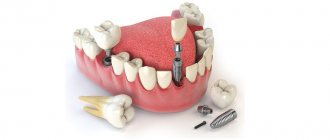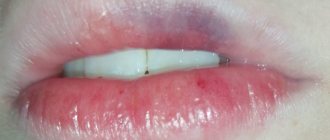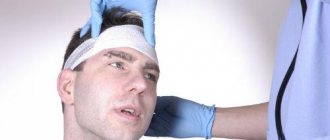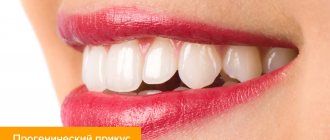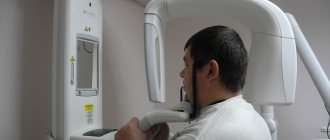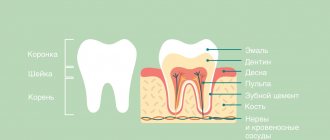Three degrees of injury:
According to statistics, 44% of all injuries are bruises, many of which require qualified assistance from a surgeon. Based on the severity of damage to tissues and joints during bruises, there are three degrees:
- Mild bruises - the functions of the bruised organ are not impaired, are accompanied by mild local pain and a late-occurring subcutaneous hematoma (12-21 hours after the injury). If there are no complications, then such bruises end with complete recovery and restoration of function.
- Moderate bruises - partial dysfunction of the organ, clear local pain, swelling at the site of the bruise, extensive hematoma, detected 3-5 hours after the injury. With a moderate injury to a joint, hemarthrosis (bleeding into the joint) is usually detected. Moderate bruises require an in-person examination by a surgeon, application of a pressure bandage, and, if necessary, removal of blood from the hematoma or affected joint.
- Severe bruises with partial or complete impairment of function due to severe pain or damage, with diffuse swelling and pain at the site of the bruise, rapidly increasing subcutaneous hematoma (1-2 hours after injury); On the 2-3rd day an intramuscular hematoma appears. In case of severe bruise of the joint, severe hemarthrosis develops, which can increase in the first 2-3 days, which indicates ongoing internal bleeding due to severe damage to the elements of the joint. Severe bruises in all cases require an in-person examination, x-rays, measures against infection and symptomatic treatment.
Bruised jaw. Consequences of injury and prevention
Go back Facial injuries are quite common. Even one careless movement can lead to a bruise or dislocation, which entails not only a painful condition, but also serious consequences, and also affects the aesthetic appearance. The most common injury is considered to be a bruised jaw. A jaw bruise is a disease that implies a mechanical injury that does not violate the integrity of the facial tissues and jaw bones. With a serious injury to the jaw, the bruise can spread to the upper and lower jaw. But, in 99% of cases, patients present with a bruise of the lower jaw. The treatment in both cases is identical. A bruise is the mildest injury, so seeking help in a timely manner will avoid unpleasant stages of the disease.
Causes
There may be several reasons that lead to a jaw bruise. The most common are: falls, as well as blows with a blunt object to the jaw area. Often such an injury can occur during a fight or an accident. How serious a bruise is can be determined based on the severity of the object during a fight or the force of the vehicle collision in an accident. A significant role is played by the elasticity of the skin and its damage before injury. After all, the healthier the bone tissue and skin on the face, the easier the bruise will be.
Symptoms
After a bruise occurs, the patient experiences the following symptoms:
- acute pain in the jaw area, which worsens during actions;
- redness of the facial skin, as well as damage in the form of scratches, abrasions and wounds;
- there is no opportunity to eat or talk;
- general deterioration of the body;
- fever and enlarged lymph nodes.
Treatment
It is quite simple to identify a jaw bruise, because it is practically no different from bruises of other parts of the body. Treatment is the same as for other bruises. The first step is to apply a bandage to the sore spot along with a cold compress of ice or cold water. Next, the jaw that has received a bruise must be provided with complete rest in order to avoid unpleasant consequences. There is no need to warm up the bruised area with heating pads or other warming agents in order to prevent inflammation from occurring. Diagnosis of a bruise can be imaginary, since behind the bruise you may not notice a dislocation or, even worse, a fracture of the jaw. Therefore, immediately after providing first aid, you should immediately go to the hospital to establish an accurate diagnosis and further treatment. An accurate diagnosis can be easily established at a medical center using an X-ray image.
Consequences and prevention
Untimely treatment of the disease or neglect of medicine can lead to very serious consequences, such as jaw deformation - periostitis. Also, untimely treatment can provoke restriction of jaw movement: the inability to fully chew or yawn. By seeking help from a doctor immediately, the disease can be treated quickly and favorably. Paying attention to your actions will help you avoid such an unpleasant injury as a bruise.
For consultations at the KIITOS dental clinic, please contact the administrators.
Surgeon's help with bruises and hematomas:
If pain is very severe, it is necessary to consult a surgeon for examination; if necessary, the patient will be prescribed analgesics. If a large hematoma has formed at the site of the bruise, it is necessary to open it - extracting liquid blood with a syringe and applying a pressure bandage. Opening the hematoma is carried out only by a surgeon to avoid infection! By opening large hematomas, the formation of scars can be avoided. Thus, when a finger is hit with a hammer (a classic case of domestic injuries among men), hemorrhage develops under the nail. The growing hematoma lifts the nail, causing significant pain. If in the first hours after a bruise you remove the blood that has flowed under the nail, you can save the nail. Also, in such cases, an x-ray of the hand is recommended to exclude a possible fracture of the phalanx of the finger.
If bleeding at the site of the injury resumes, then the hematoma is opened, or the bleeding vessel is tied up or a vascular suture is applied. If the hematoma festers, it must be urgently opened and drained; the wound is left with drainage to drain purulent contents.
The accumulation of blood in the joint can cause chronic synovitis and bursitis, therefore, if a bruise causes hemorrhage into the joint (hemarthrosis), it is necessary to extract blood from the joint cavity. To speed up the healing of moderate and severe joint bruises, physiotherapy, massage, and exercise therapy are recommended from the 3-5th day. Competent treatment tactics, taking into account concomitant pathology and an individual approach to each patient in our clinic are the key to successful treatment of this pathology.
First aid for childhood injuries
All mothers know for sure: something always happens to children! Either they fall into a puddle, or they stick their fingers in a socket. In order to be prepared for any emergency, we will describe all the necessary actions of the parent before the ambulance arrives. After all, the main thing in this matter is not to harm, but to help.
Sun or heatstroke
The situation arises when a child spends a long time in the open sun without a hat. Due to the rush of blood to the brain, the following symptoms appear:
- nausea;
- vomit;
- shallow breathing;
- convulsions;
- loss of consciousness.
In order to provide first aid, it is necessary to move the victim into the shade, open or remove his clothes and lay him down so that the head is higher than the body. The baby's face, neck and chest should be wiped with cold water. You should also place a cold, wet towel on your forehead to cool down. Reduce the temperature with children's antipyretics. Give as much to drink as possible.
Frostbite
Damage to tissue under the influence of cold can occur not only in severe frosts, but even at temperatures of 0 - +3 degrees. This situation often arises if the child has been walking in wet clothes or in a strong wind.
To provide first aid, it is necessary to maintain a sub-zero temperature on the surface of the damaged area of skin. To do this, apply a thermal insulating bandage, which includes 4 layers: bandage + cotton wool + oilcloth (or plastic bag) + scarf. The child must be given a warm drink and covered with a blanket.
Attention! Under no circumstances should you rub the skin in the area of frostbite with snow or mittens. This will damage the skin and may result in infection. Also, you should not warm up a frostbitten area with warm (and even more so hot!) water - serious consequences can occur.
Burn
According to statistics, burns are considered the most common injuries in childhood. If a burn occurs, it is necessary to irrigate the affected area with a cold stream of water. Continue these manipulations for 10-15 minutes. You should never treat a burn with iodine, potassium permanganate, or oil. No “peeing” on damaged skin, no applying potatoes and other unthinkable methods! With an extensive burn, every second is important - we wrap the child in a clean, freshly ironed sheet, give him warm tea and take him to the clinic as soon as possible.
Electric shock
If a child receives an electrical injury, immediately remove it from the source of electricity. However, it should be understood that at this moment the victim himself becomes a conductor of current, and can only be touched while wearing rubber gloves or standing on a rubber surface. Electrical wires can also be pulled away from the child using a dry branch.
In case of respiratory arrest, it is necessary to perform a cardiac massage. To do this, press your hands on your chest 30 times, then exhale air into your mouth 2 times. The steps should be repeated until the ambulance arrives.
Even if a child who has received an electric shock does not complain of feeling well, he or she must be shown to a doctor in any case. The negative effects of current on the body may not appear immediately.
Injury
Bruises are injuries to body tissues without compromising the integrity of the skin. The main symptom of a contusion is a bruise or hematoma. After an injury, the child feels pain and swelling may occur.
The main action of parents for bruises is to apply cold to the damaged area. Any frozen product from the freezer, pre-wrapped in a scarf or thin towel, will do. After 2-3 days, on the contrary, a warm heating pad is applied to the site of the bruise. In case of a bruise in the joint area, it is necessary to immobilize it.
Attention! In case of a strong blow, it is imperative to show the child to a doctor to exclude serious dislocations and fractures.
Sprained or torn ligaments
In most cases, when a ligament is sprained or torn, the ankle joint is affected. After a child twists his foot, he feels a sharp pain. At this time, swelling appears on the outer surface of the joint.
When a ligament is sprained or torn, cold must be applied to the damaged joint and secured with a figure-of-eight bandage. To ensure that a sprained leg does not cause a bone fracture, it is recommended that the child be shown to a doctor.
Fracture
This is one of the most dangerous injuries, requiring not only knowledge of immediate care, but also subsequent rehabilitation. Open fractures are considered the most dangerous, as there is a high risk of infection through damaged tissue.
In the case of an open fracture, the first action of the parent is to stop the bleeding using a sterile bandage (we will discuss bleeding in more detail below). If the ends of bones and fragments are found, do not under any circumstances try to bury them deep into the wound. Broken limbs must be immobilized using a splint made from scrap materials. These can be boards, sticks, pieces of cardboard, etc. If your arm is broken, you can bandage it to your body. The broken leg can be carefully bandaged to the uninjured leg. The victim must be moved very carefully, without causing additional injury.
If the spine is fractured, the child must be moved in a lying position. A sitting position is not allowed. Transportation takes place on a shield or stretcher with a solid frame. If a fracture of the pelvic bones is suspected, the victim should be placed on a stretcher, placing a bolster under his bent, separated knees.
Wound
Any, even the smallest, wounds are an open gate for infection. Often, infection occurs as a result of improperly provided care.
If a wound occurs, clean the damaged skin from dirt (movements are made from the edges of the wound to its outer part), cover with a sterile bandage. When providing assistance, do not examine the wound with your fingers and do not wash it with any liquids. When treating with brilliant green or iodine, make sure that the product does not get on the wound itself, only on its edges.
If the applied bandage becomes saturated with blood, do not try to remove it; it is better to apply another additional layer of bandage on top.
Bleeding
The tactics to stop bleeding depend on its type. So, in case of venous or capillary bleeding, the child’s injured limb should be raised and a pressure bandage applied to the wound. For arterial disease, a tourniquet will be required.
In order to apply the tourniquet correctly, it should be fixed on a soft lining (any fabric will do). When applying, it is necessary to monitor the bleeding: as soon as it has stopped, the pressure of the tourniquet must be left at this level. No need anymore!
It is necessary to record the time of application of the tourniquet and ensure that the duration of the tightening in the summer does not exceed 40 minutes, in the winter - 20. To control the situation, you should not cover the tourniquet with clothing.
Traumatic brain injury
The main task of parents when a child receives a skull injury is to create complete peace. In case of an open wound, apply a tight sterile bandage. If vomiting occurs, care must be taken to ensure that the child does not choke on the vomit. It is better to carry the victim in your arms to the doctor.
Attention! For any traumatic brain injury, a child must be seen by a doctor. Underestimating the seriousness of the incident can lead to serious consequences: headaches, memory impairment, fatigue, etc.
All these recommendations will help you not to get confused in the event of an accident and provide your child with competent pre-medical care in a timely manner. But to avoid having to do this, take care of your children!
